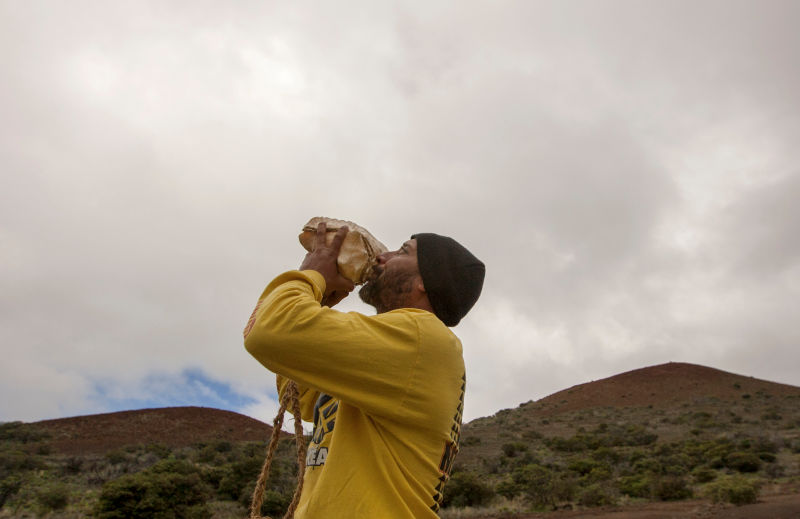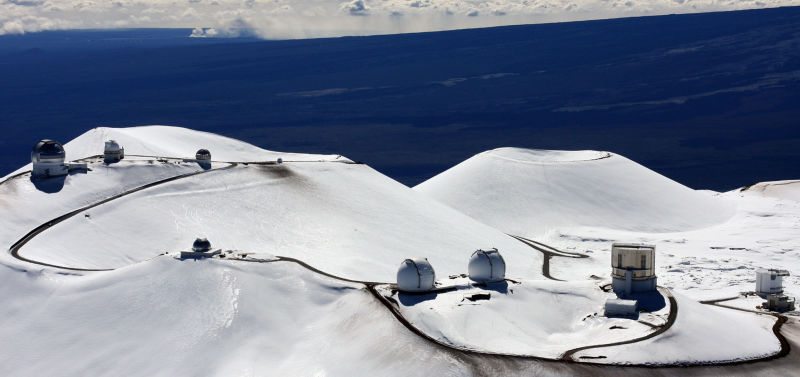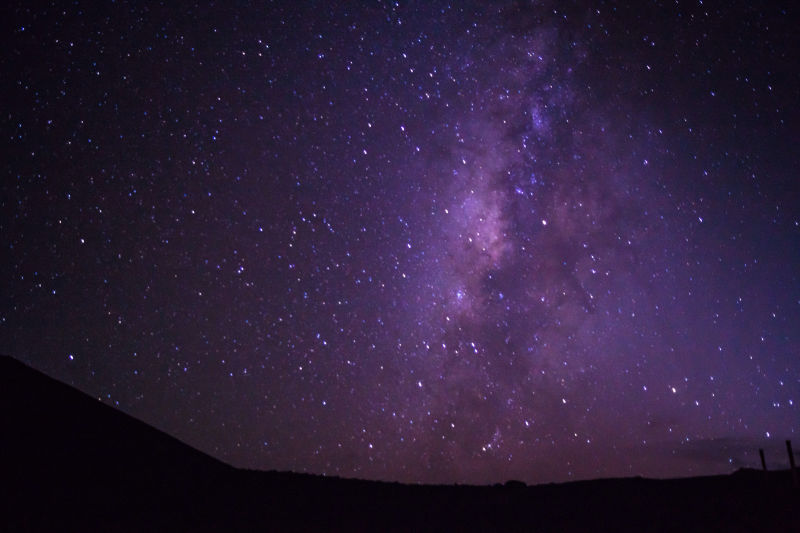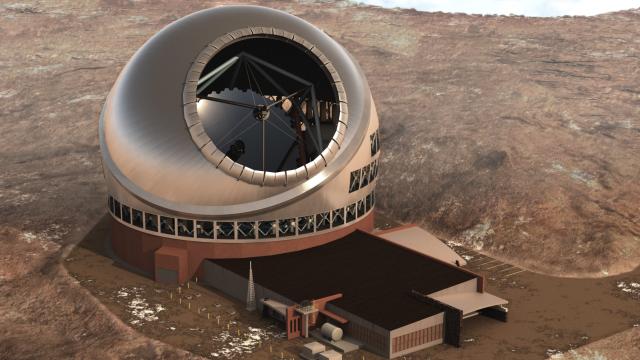For years, it seemed as if the future of the Thirty Meter Telescope was writ in the stars. The enormous, next-generation observatory would explore the birth of galaxies and seek signs of life on alien worlds from atop the dormant volcano of Mauna Kea, one of the best places on Earth to study the sky.
But last spring, when the telescope’s leadership quietly announced it had secured a backup site on the Spanish island of La Palma, it became clear there are more things in this life than even the owners of a 30m looking glass can predict.
The TMT might not be built in Hawaii after all — the latest development in a bitter battle over the placement of this larger-than-life machine, whose otherworldly agenda, including catching the first light from the dawn of the universe, comes at a price. To the native Hawaiians who hold Mauna Kea sacred, the 55m-tall observatory would be a desecration — which is why they’re opposing it in court.
The telescope’s fate is expected to be decided in a contested case hearing early this year. If the TMT winds up moving to Spain’s Canary islands, it’d be a major win for the project’s critics, whose opposition to the development of Mauna Kea for astronomy fell on deaf ears for decades. (The mountain’s summit is already home to 13 world-class observatories.)
But would moving the TMT be a loss for science? That’s the billion-dollar question facing astronomers, and, as with every facet of the debate surrounding this telescope, there’s no cut-and-dry answer.

A rendering of the Thirty Meter Telescope, courtesy TMT International Observatory
Star-gazing conditions aside, the timing of the telescope’s construction is crucial. Its location could dictate its use in ways that, for better or worse, shape the future of astronomy. Finally, whether the TMT moves or stays put will have ripple effects on the relationship between native Hawaiians and the scientific community.
A $US1.4 billion ($1.7 billion) observatory wielding a 30m-wide primary mirror, the TMT is a prodigious international collaboration sponsored by Japan, China, the US, Canada and India, and partially funded by nonprofits, the University of California and Caltech. Once finished, the observatory will have 12 times the resolution of the famous Hubble Space Telescope, with especially good optics in the infrared spectrum used to study faint objects like exoplanets, and to catch redshifted light from the early universe.
Together with two southern hemisphere counterparts — the European Extremely Large Telescope (E-ELT) and the Giant Magellan Telescope (GMT) now under construction in Chile — the TMT is expected to usher in a new era of astronomy, one in which scientists can study the hidden structure of the universe and detect fingerprints of life in the atmospheres of distant worlds. The TMT, E-ELT and GMT are collectively referred to as the “extremely large” telescopes because their size. But the label is also befitting of their mission, which is to answer some of the largest questions humans have ever dared pose.
The reason astronomers want to build the TMT on Mauna Kea is simple. “Mauna Kea is the best place to study the stars in the northern hemisphere,” said Fiona Harrison, a professor of physics and astronomy at Caltech who serves on the telescope’s board of governors.
The eighth tallest mountain in the solar system, and the tallest on Earth as measured from its underwater base, Mauna Kea soars high above the clouds, its snow-dusted peaks forming a 4207m sky island that feels a world apart from the tropical landscapes below. With no light pollution, little water vapour and only a thin atmosphere to interfere, Mauna Kea’s view of the sky is as clear and pristine as they come. The summit of Mauna Kea is also cold — a bonus for infrared astronomers, whose job entails teasing out faint cosmic heat sources from everything else with a temperature.
Most importantly, thanks to the peculiar atmospheric dynamics that arise when one sticks a shield volcano in the middle of the Pacific, air turbulence atop Mauna Kea is exceptionally low.
“The stars don’t twinkle so strongly,” said Guenther Hasinger, director of the Institute for Astronomy at the University of Hawaii. “That gives you a better signal than anywhere else in the world.”
“All images are tighter, and higher resolution, if you have less turbulence,” added Nick Suntzeff, an astronomer at Texas A&M University who has been involved in the site-selection process for Chilean observatories.

A Hawaiian who opposes construction of the Thirty Meter Telescope blows a conch shell near the summit of Mauna Kea in August 2015. Image: Caleb Jones/AP
It’s small wonder that Mauna Kea’s spare slopes have attracted scientists from around the world. But long before this mountaintop was home to modern observatories, it was the temple of another celestial tradition. For centuries, Hawaiians have travelled to this ancient summit seeking wisdom and connection with their gods, to bury their ancestors and to learn how to navigate by the stars. As Kealoha Pisciotta of the native Hawaiian organisation Mauna Kea Hui put it to Gizmodo before, in the eyes of her people Mauna Kea “is not a realm for mankind, but a realm where we go to learn the ways of the heavens”.
For many Hawaiians, Mauna Kea is sacred ground that should be left untouched. But since the 1960s, the development of the mountaintop for astronomy has taken precedence over this view, again and again. The conflict is often, and erroneously, portrayed as a clash between science and religion. More accurately to those who oppose construction on Mauna Kea, it is a rebuke against colonialism, which has been transforming life on the Big Island ever since the United States overthrew the sovereign and world-recognised Kingdom of Hawaii in the late 19th century. To some, Mauna Kea’s crown of observatories epitomise the intrusion of Western ideology — not least because they literally sit atop the oldest and most significant ancestor in native spirituality.
Others have voiced more material concerns with the telescopes; namely the handling of wastewater and hazardous materials, impacts on ancestral burial sites and interference of the observatories with the mountaintop’s spiritually-significant viewshed. These are concerns are not unfounded: Reportedly, early construction crews were callous about to the mountain’s religious and cultural significance, bulldozing family shrines and burial sites. Incidents involving the spilling of industrial and caustic chemicals, while infrequent and duly reported, have left land protectors on a hair trigger. But perhaps the most significant ammo in the critics’ arsenal is an environmental impact assessment conducted by NASA prior to construction of the Outriggers Telescope Project in 2004. That assessment, prompted by backlash from the native Hawaiian community, concluded that “from a cumulative perspective, the impact of past, present, and reasonably foreseeable future activities on cultural and biological resources on Mauna Kea is substantial and adverse”.

Aerial view of observatories atop Mauna Kea. Image: Tim Wright/AP
Saddled with historical baggage, it’s no surprise that the TMT — which would be the mountain’s 14th observatory, and its largest one yet — has faced opposition from the get-go. To the observatory’s credit, its leaders have attempted to engage native Hawaiians earlier and more often than ever before, holding hundreds of community meetings to share and discuss their work, and retooling the observatory’s design to minimise its physical footprint and visual impact on the mountain.
But to some opponents, these gestures of reconciliation come as too little, too late. That much became abundantly clear in the spring of 2014, when dozens of protesters blocked TMT construction crews from heading up the mountain to break ground. Very quickly, the opposition movement garnered international attention, attracting allies around the world.
Meanwhile, the Hui took legal action against the telescope, alleging that Hawaii’s Board of Land and Natural Resources (BLNR) had violated due process by issuing a construction permit for an observatory in a conservation district, before allowing opponents to air their complaints in a contested case hearing. In December 2015, the Hawaiian Supreme Court decided that the Hui were right.
“Quite simply, the Board put the cart before the horse when it issued the permit before the request for a contested case hearing was resolved and the hearing was held,” the court decision reads. “Accordingly, the permit cannot stand.”
Now, a contested case hearing is finally underway. But with no guarantees as to the outcome, a future for the TMT in Hawaii is far from assured, even as those who support astronomy on Mauna Kea continue to make concessions. (In 2015, governor David Ige vowed to remove at least three of the mountain’s 13 existing observatories by the early 2020s. That same year, the University of Hawaii agreed that the TMT would be the last new construction site on the mountain.)
Amidst uncertainty, the telescope’s board began shopping around for a new home last year.
“Mauna Kea continues to be our preferred choice for the telescope,” Harrison said. But, she added, “both to be competitive scientifically in terms of getting the scope online, and because the project cost increases with additional schedule slips, we started this fairly intensive effort to consider alternate sites.”
After months of deliberation, the TMT whittled those alternates down to three locations: A mountaintop in Baja California, Mexico; La Palma in Spain’s Canary Islands; and a high-elevation site in Chile. Moving to the southern hemisphere was quickly ruled out, because it would leave the northern sky bereft of an extremely large telescope.
Eventually, the board decided on La Palma, mainly because the island’s peak, Roque de los Muchachos, is already home to one of the world’s leading optical observatories. Should the TMT set up shop next door, the infrastructure already in place on La Palma will save construction crews precious time.
Most astronomers agree that La Palma is an inferior site when it comes to observing the stars. Roque de los Muchachos peaks at a much lower elevation — 2423m — meaning the air is denser, warmer and less ideal for observations in certain parts of the spectrum, including blue and near-ultraviolet wavelengths. There are more wet nights on which the telescope wouldn’t have good visibility. The atmospheric turbulence is greater.
But despite its drawbacks, La Palma is still an outstanding site for astronomy. Harrison, for one, firmly believes that science at the TMT will not suffer greatly should the telescope move. “We may have to do more adaptive scheduling,” she said, “but the TMT can still achieve all of its science objectives [at La Palma].”

Milky Way from near the summit of Mauna Kea. Image: Mark Ireland / Flickr
That the TMT is putting on a good face about moving halfway around the world to its second-choice site underscores another key factor: Not where the telescope is built, but when. The board is trying desperately to stick to an April 2018 construction deadline. If that deadline is missed, costs rise and partner institutions become unhappy. But most importantly, if its construction schedule is pushed back any more, the TMT risks falling behind its southern hemisphere counterparts, which are expected to see first light in 2024.
Falling behind could cause the TMT to lose out on some major opportunities. To wit, the first extremely large telescope on the sky will be the first to probe the atmospheres of rocky, Earth-sized exoplanets. It may be the first human-made instrument to find definitive signs of an alien biosphere.
“You want to be a part of that discovery,” Suntzeff said. “Not just for the glory, but because it’s such a cool thing in the history of humanity.”
“There is a competition, definitely,” said Marc Sarazin, an astronomer at the European Southern Observatory who has led extensive site surveys in Chile. “We collaborate, but the first [of these telescopes] on the sky will do big science. Delay such a project by a few years, and you may just lose the Nobel Prize.”
Beyond the history-making discoveries, any decisions about the placement of the TMT could have far-reaching effects on who leads astronomy in the next decade. The University of Hawaii has long benefited from having a cadre of world-class telescopes in its backyard: With a full 10 per cent of observing time on Mauna Kea allotted to the state, it’s been able to attract some of the brightest minds in the field. In addition to creating local jobs, Mauna Kea’s observatories are a big source of revenue for the state, generating roughly $US60 million ($79 million) in earnings and taxes in 2012, according to a 2014 report.
“Without the TMT, I think we still have some of the best on the mountain and will lead the world for at least a decade,” Hasinger said. “But I would expect, if the TMT would not come to Hawaii, it would have a chilling effect on the future of astronomy here.”
Spain, unsurprisingly, feels differently about the TMT’s potential move. “IAC would be very pleased to host the TMT in its observatories if finally [they] could not be built in Hawaii,” said Rafael Rebolo López, the director of the Instituto de Astrofisica de Canarias (IAC), which heads up observatories on the islands of Tenerife and La Palma. “TMT would offer the opportunity of extraordinary scientific achievements to the IAC and to Spanish astronomy in general.”
“Without any doubt, the location in the Canary islands would increase the collaboration of Spanish astronomers with those in California, Canada, Japan, China and India,” López added. “We are already part of many international collaborations in astrophysics… and we value how crucial this cooperation is for the development of our own astrophysical research.”
Finally, there’s another important group of stakeholders to consider in all of this, and that’s the native Hawaiians waiting to see if a 14th observatory will be permitted on their sacred mountain. It should be noted that roughly half of these men and women — 46 per cent, according to a recent poll — support construction of the TMT. Another 45 per cent oppose it.
“You have to understand, we’ve spent literally decades, in hearings with hundreds of people, asking for relief from further development,” Pisciotta, a former telescope operator with longstanding ties to the astronomical community of Hawaii, said. “We are not opposed to science, but we are opposed to science trumping everything.”
Some astronomers have expressed similar views. “As an astronomer, I would hope astronomers and native Hawaiians could share the mountain,” Suntzeff said. “But a huge part of human rights is respecting and understanding the cultures of people who’ve lived somewhere for a long time.”
“I think that historically, the community has not done a good job of engaging the concerns of the native Hawaiians,” said John O’Meara, an astrophysicist at St Michael’s College, who describes himself as “largely supportive” of the TMT’s backup site in the Canary Islands, while still preferring Mauna Kea. “In recent years, I think TMT has helped reverse that course in a much more collaborative and engaging way.”
“That said,” he continued, “we cannot ignore the importance of Mauna Kea to Hawaiians, and should ensure that any construction in the future on the mountain (if it occurs) have as minimal impact as possible.”
Ultimately, could moving the TMT could help rebuild trust between the two communities for whom Mauna Kea’s pristine skies are a wellspring of celestial wisdom and wonder? “I think people are very open and want to have a better relationship,” Pisciotta said. “Moving this scope would be a step in the right direction.”
As to what such an outcome would mean for astronomy, Suntzeff summed up the predicament succinctly. “I cannot give a number to the advantage of putting a scope at the world’s best site,” he said. “But there is an advantage.”
